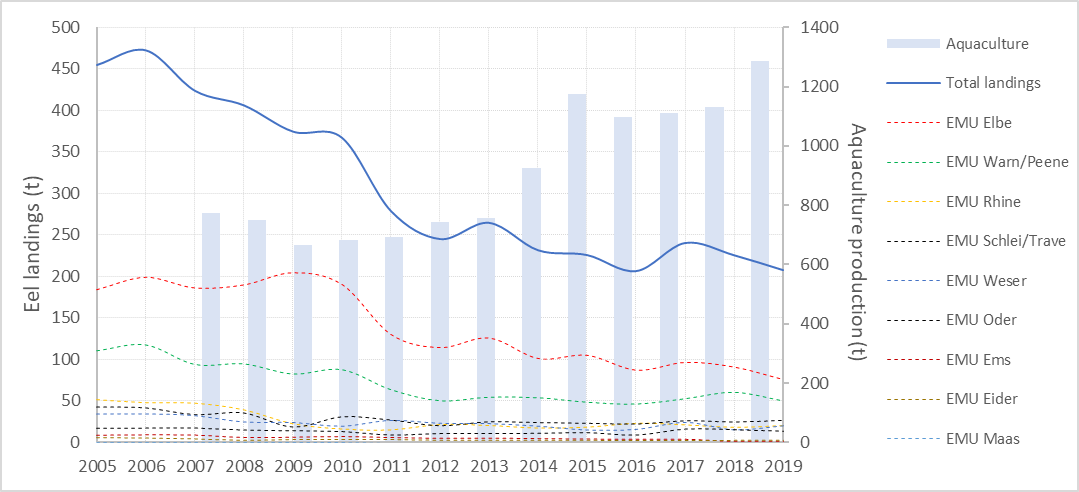Eel landings and aquaculture production in Germany
In order to stabilize the stock of the European eel (Anguilla anguilla), which is classified as critically endangered, the Europe-wide coordinated stock management provides a number of measures - including the restriction of fisheries. German eel catches show a strong decrease in landings between 2005 and 2012. Since then, catches have only decreased slightly and even have increased again in some rivers. During the same time period, eel production in German aquaculture has almost doubled.
Between 2005 and 2019, annual eel catches in Germany decreased from around 455 to around 208 tons. This corresponds to a reduction of about 54%. It can be observed that most of the decline happened between 2005 and 2012. This period accounted for 85% of the total catch decrease, while after 2012 landings have only slowly decreased and are even increasing again in some rivers. At the same time, German eel aquaculture is experiencing strong growth. Within 10 years, the annual production of eels has almost doubled from about 670 t to over 1200 t.
The European eel is considered as critically endangered and since 2008 the management of the stock is coordinated across Europe in order to recover from the extremely low number of juvenile eels that recruit to the European and Northern African coasts. Against this background, EU member states are obliged to take measures to protect the eel - this includes reducing human-related mortality, such as from hydroelectric power plants or fisheries. Also, the International Council for the Exploration of the Sea (ICES) advised in its last year’s report to stop eel fisheries on all life stages immediately. Since the German eel fishery is largely dependent on stocking measures, the effect of the extremely low recruitment is not fully reflected by landings. Nevertheless, a sharp decline in eel catches can be observed in the period before 2012. Subsequently, the decreasing trend in catch numbers weakens and is almost entirely caused by the decline in the Elbe Eel Management Unit (EMU). Although there were also declining eel catches in the EMUs Weser and Ems, these together account for just under 18% of the decline after 2012. In the EMUs Rhine, Warnow/Peene and Eider catches are stagnating, while in the EMUs Oder and Schlei/Trave landings increased after 2012 by 29 and 33%, respectively.
The production of eels in German aquaculture reached 1,286 t in 2019. This was preceded by an increase of 48% within the last 10 years. Since the reproduction of eels in captivity is not possible, eel aquaculture is stocked 100% with wild catches. An increase in aquaculture production is therefore only possible by using an increasing amount of glass eels from wild origin. A growing eel aquaculture therefore also leads to increased fishing pressure on the eel stock and cannot be regarded as sustainable in its current form.
- More information: „Sustainable use of the European eel“
- Kontact: Dr. Lasse Marohn
- Kontact: Prof. Reinhold Hanel

![[Translate to English:] [Translate to English:]](/media/_processed_/2/9/csm_Embryo-Exp_Gelege_9F_dpf5-200513111619_c8534a8199.jpg)
![[Translate to English:] [Translate to English:]](/media/_processed_/2/9/csm_Embryo-Exp_Gelege_9F_dpf5-200513111619_9027994d44.jpg)






